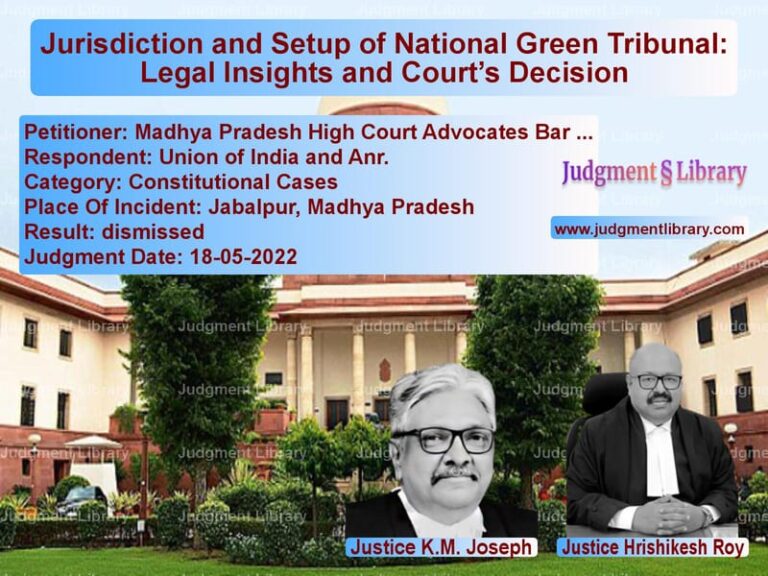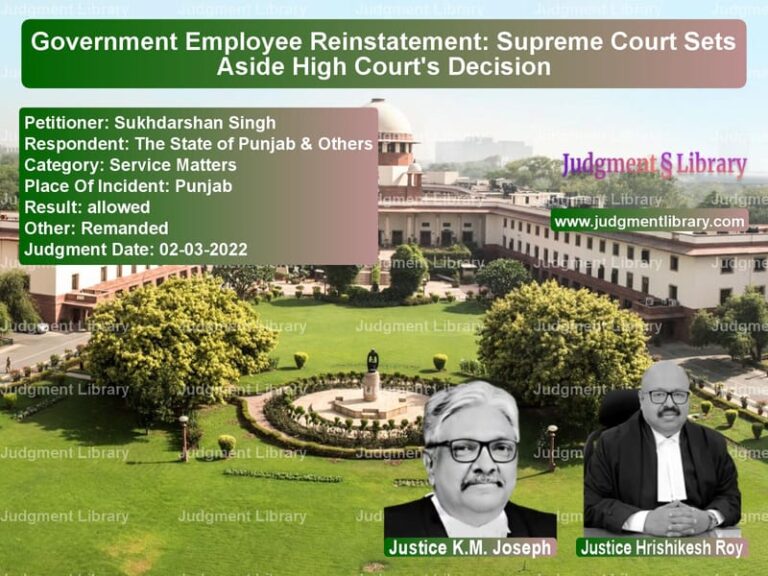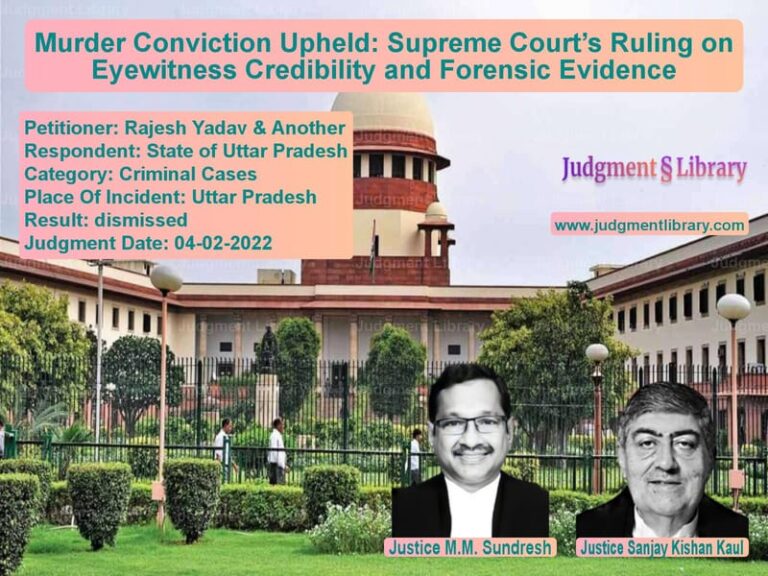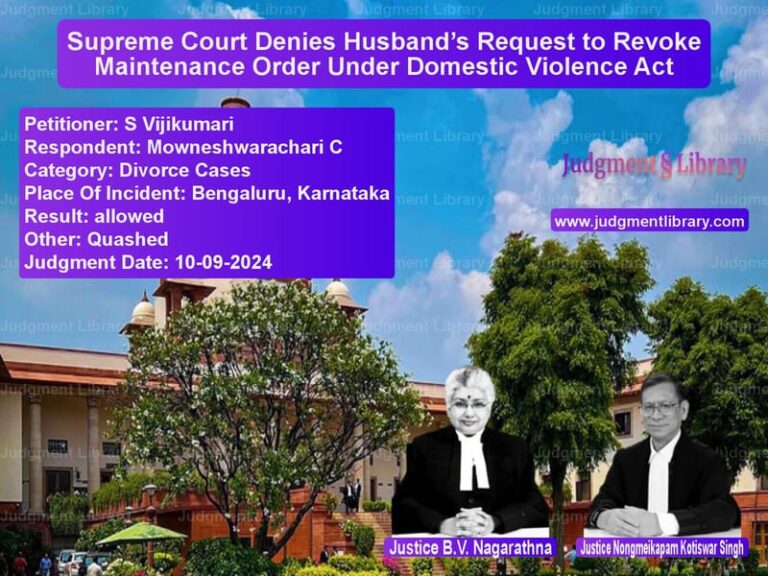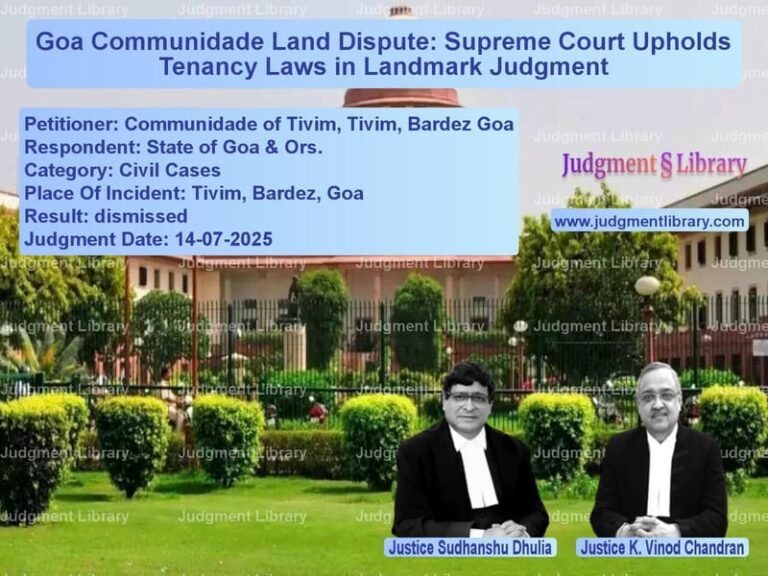Supreme Court Orders Release of Juvenile Murder Convict: Landmark Juvenile Justice Ruling
In a landmark judgment that underscores the paramount importance of juvenile justice principles in India’s legal system, the Supreme Court recently delivered a significant ruling that highlights how the law must treat young offenders differently from adults, even in the most serious of crimes. The case involved Hansraj, who was convicted for a murder committed when he was just 12 years old, and who had spent nearly four years in custody despite being entitled to the protections afforded to juvenile offenders. The Court’s decision brings into sharp focus the delicate balance between the seriousness of the crime and the special considerations that must apply when the offender is a child, emphasizing that the law’s primary concern in such cases should be reformation rather than retribution.
The Tragic Incident and Long Legal Battle
The case has its origins in a tragic incident that occurred on November 2, 1981, when Hansraj, then merely 12 years and 5 months old, along with five others, was accused of assaulting the father of the first informant with knives and lathis. The victim succumbed to his injuries the following day, leading to the registration of an FIR under Sections 302/149, 147 and 148 of the Indian Penal Code. The petitioner was arrested on November 6, 1981, and remained in custody as an undertrial for 1 month and 3 days before being released on bail on December 8, 1981.
The legal proceedings that followed spanned decades, reflecting the complex journey of the case through India’s judicial system. The petitioner and co-accused were tried by the Special Additional Sessions Judge, Sultanpur, in Sessions Trial No. 8 of 1983. In a judgment dated August 14, 1984, the Sessions Court convicted the petitioner and others for the murder of the victim. However, recognizing the petitioner’s youthful age, the Sessions Court, in its order of sentence dated August 16, 1984, noted that he was entitled to the benefit of the Children Act, 1960. Instead of sending him to jail, the court directed that he be kept in a children’s home to provide him with an opportunity for reformation.
The convicts, including Hansraj, challenged their conviction before the Allahabad High Court, which acquitted them through its judgment dated April 7, 2000. The State of Uttar Pradesh, aggrieved by this acquittal, appealed to the Supreme Court, which, on May 8, 2009, reversed the High Court’s order and restored the conviction and sentence imposed by the Sessions Court. Following this restoration of conviction, the petitioner absconded and could only be arrested on May 19, 2022, remaining in custody since then.
The Legal Question Before the Supreme Court
The central legal question before the Supreme Court was whether the petitioner, who was unquestionably a juvenile at the time of the offense, was entitled to the benefits under the Juvenile Justice (Care and Protection of Children) Act, 2000, particularly Section 7-A, which was inserted with effect from August 22, 2006. This provision is crucial as it establishes the procedure to be followed when a claim of juvenility is raised before any court. Section 7-A(1) states that whenever such a claim is raised, the court shall make an inquiry to determine the age of the person and record a finding regarding their juvenile status. Most importantly, the proviso to this subsection clarifies that “a claim of juvenility may be raised before any court and it shall be recognised at any stage, even after final disposal of the case, and such claim shall be determined in terms of the provisions contained in this Act and the rules made thereunder, even if the juvenile has ceased to be so on or before the date of commencement of this Act.”
The Arguments Presented by Both Sides
Mr. Parinav Gupta, the learned counsel for the petitioner, presented compelling arguments centered on the fundamental rights of the petitioner as a juvenile offender. He contended that “the petitioner has been behind bars for more than 3 years and 8 months despite being a juvenile who is entitled to the benefit of the JJ Act, 2000. According to him, the maximum period of detention of a juvenile is 3 years as per Section 15(1)(g) and detention in excess of such period of 3 years would amount to an illegal detention. This, being in clear breach of the petitioner’s right to life protected by Article 21 of the Constitution of India, he ought to be immediately released from illegal detention.” The counsel relied on several precedents, including Pratap Singh v. State of Jharkhand, Satya Deo @ Bhoorey v. State of Uttar Pradesh, and Vinod Katara v. State of Uttar Pradesh, to bolster his argument that the petitioner’s continued detention violated constitutional protections.
Opposing the writ petition, Mr. Neeraj Shekar, representing the respondent-State, advanced several arguments seeking to deny relief to the petitioner. He contended that “the date of occurrence of crime is 2nd November, 1981; and, therefore, the provisions of the 1960 Act would be applicable and not the JJ Act, 2000, as contended on behalf of the petitioner.” He further argued that “the petitioner was found guilty of a heinous offence and, therefore, he is not entitled to any mercy.” Referring to the decision in Shilpa Mittal v. State (NCT of Delhi), he contended that murder, carrying a minimum sentence of life imprisonment, must be regarded as a heinous offense. Additionally, he highlighted that “despite this Court by its order dated 8th May, 2009 having reversed the acquittal recorded by the High Court, the petitioner did not surrender and evaded arrest by absconding. He could only be arrested on 19th May, 2022. Culpability being writ large, it is finally contended that this Court may refuse to exercise discretion in favour of the petitioner.”
The Supreme Court’s Legal Analysis and Reasoning
The Supreme Court, comprising Justices Dipankar Datta and Augustine George Masih, conducted a thorough analysis of the legal principles governing juvenile justice in India. The Court began by acknowledging the undisputed fact that “the petitioner was 12 years 5 months old on the date of the incident.” This factual foundation became the cornerstone of the Court’s reasoning.
The Court meticulously examined the nature of the petitioner’s involvement in the crime, noting that “in the absence of any specific role played by the petitioner, the Sessions Court recorded conviction against the petitioner by taking aid of Section 149 of the IPC, i.e., he was member of an unlawful assembly which perpetrated an act in furtherance of a common object and, therefore, would be liable thereunder.” This observation highlighted that the petitioner’s conviction was based on collective liability rather than direct individual action.
The Court placed significant emphasis on the statutory framework governing juvenile justice, particularly Section 7-A of the JJ Act, 2000. The Court noted that “Section 7-A of the JJ Act, 2000, relevant for the present case, permits raising of a plea of juvenility in any court at any stage and even after final disposal of a special leave petition under Article 136 of the Constitution. On the plain terms of Section 7-A, the courts are under an obligation to consider the plea of juvenility and to grant appropriate relief if, at all, in an enquiry it is found that the convict was a juvenile on the date of offence.”
The Court extensively relied on precedent to support its interpretation. Referring to the Constitution Bench decision in Pratap Singh, the Court observed that the JJ Act, 2000 would apply to any proceeding pending before any court or authority when the Act came into force. The Court also cited Dharambir v. State (NCT of Delhi), where it was held that “all persons who were below the age of eighteen years on the date of commission of the offence even prior to 1st April, 2001 would be treated as juveniles even if the claim of juvenility is raised after they have attained the age of eighteen years on or before the date of commencement of the JJ Act, 2000 and were undergoing sentences upon being convicted.”
Addressing the practical aspects of the case, the Court noted that “the petitioner has suffered incarceration for more than the period permissible in law. Moreover, the purpose for which the Sessions Court directed the petitioner to be kept in a children’s home is no longer feasible now.” The Court also raised concerns about procedural irregularities in the original trial, noting that “We have also not been shown by Mr. Shekar why provisions contained in Section 24 of the 1960 Act – prohibiting joint trial of a child with a person who is not a child – was observed in the breach.”
The Court’s Final Ruling and Its Constitutional Significance
In its concluding analysis, the Court powerfully stated that “Since there is no quarrel with the fact that the petitioner was a child at the time of commission of the offence and the petitioner having been behind bars for more than 3 years, his liberty has been curtailed not in accordance with procedure established by law. Breach of the right guaranteed by Article 21 is writ large and, hence, the benefit of release from detention ought to be extended to the petitioner.”
Accordingly, the Court allowed the writ petition and ordered that “The petitioner shall be immediately released, if not wanted in any other case.” The Court also issued practical directions to facilitate the petitioner’s release, stating that “The Senior Superintendent, Central Jail, Varanasi, shall act on the basis of a downloaded copy of this judgment and order as and when produced, without insisting for a certified copy thereof.”
This judgment represents a significant affirmation of juvenile justice principles in India’s legal system. It reinforces the idea that the age of the offender at the time of the crime is the determining factor for applying juvenile justice protections, regardless of when the legal proceedings occur or how much time has passed. The Court’s reasoning emphasizes that the object and purpose of juvenile justice legislation is to provide a protective framework for young offenders, focusing on their reformation and rehabilitation rather than punitive measures. The decision also underscores the constitutional dimension of juvenile justice, linking it directly to the fundamental right to life and personal liberty under Article 21 of the Constitution. By ordering the release of a convict in a murder case solely on the basis of his juvenile status at the time of the offense, the Supreme Court has sent a powerful message about the primacy of juvenile justice principles in India’s legal landscape.
Petitioner Name: Hansraj.Respondent Name: State of U.P..Judgment By: Justice Dipankar Datta, Justice Augustine George Masih.Place Of Incident: Sultanpur, Uttar Pradesh.Judgment Date: 09-10-2025.Result: allowed.
Don’t miss out on the full details! Download the complete judgment in PDF format below and gain valuable insights instantly!
Download Judgment: hansraj-vs-state-of-u.p.-supreme-court-of-india-judgment-dated-09-10-2025.pdf
Directly Download Judgment: Directly download this Judgment
See all petitions in Juvenile Justice
See all petitions in Murder Cases
See all petitions in Bail and Anticipatory Bail
See all petitions in Fundamental Rights
See all petitions in Custodial Deaths and Police Misconduct
See all petitions in Judgment by Dipankar Datta
See all petitions in Judgment by Augustine George Masih
See all petitions in allowed
See all petitions in supreme court of India judgments October 2025
See all petitions in 2025 judgments
See all posts in Criminal Cases Category
See all allowed petitions in Criminal Cases Category
See all Dismissed petitions in Criminal Cases Category
See all partially allowed petitions in Criminal Cases Category


